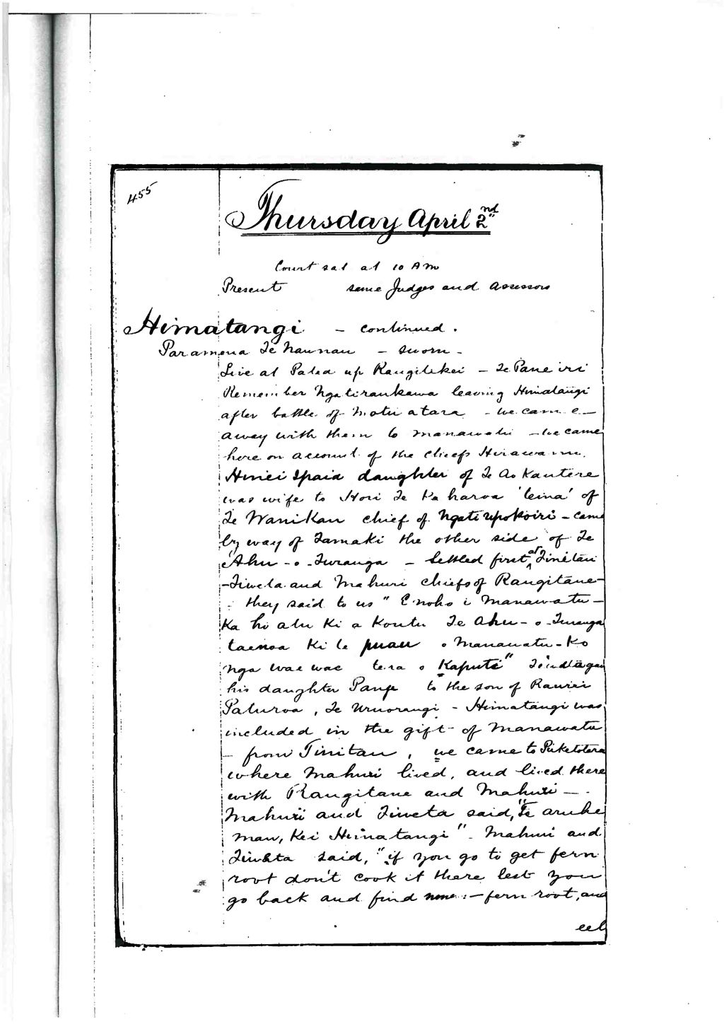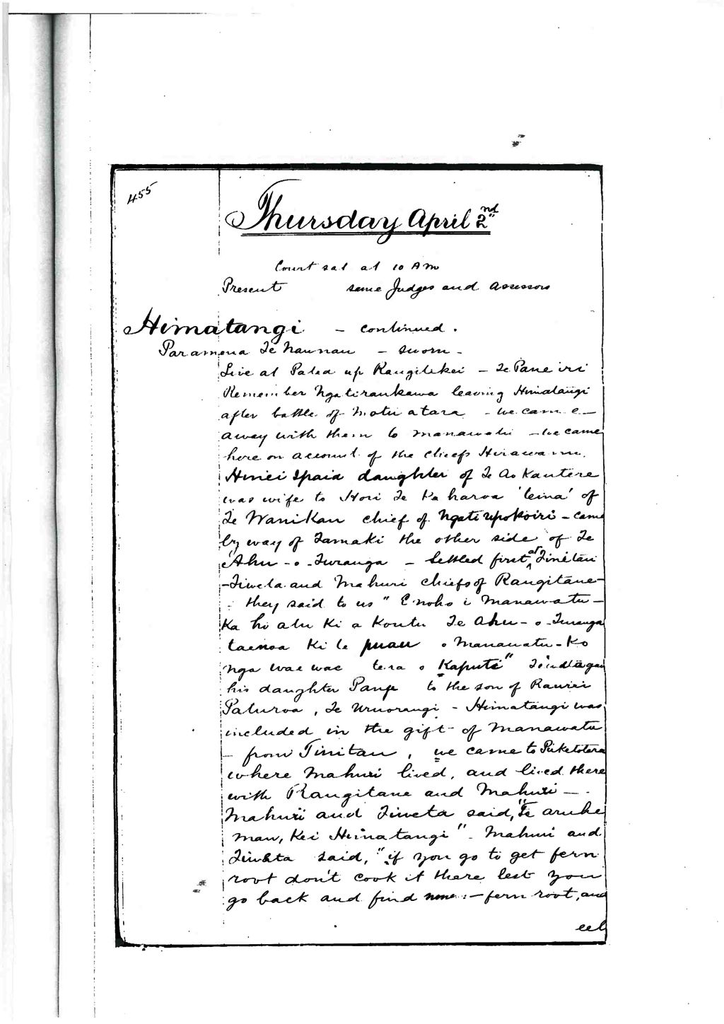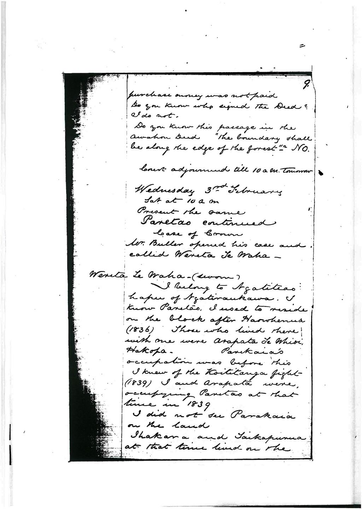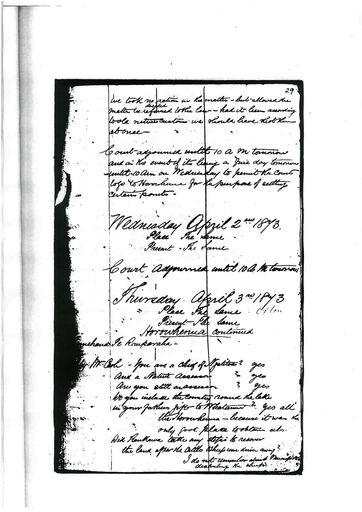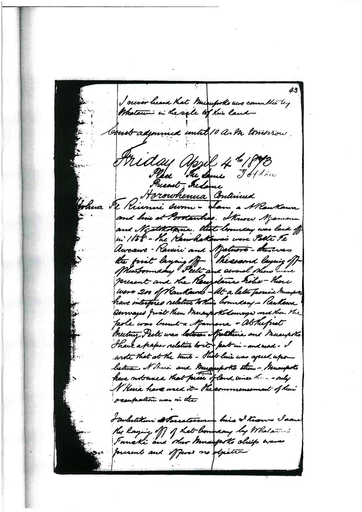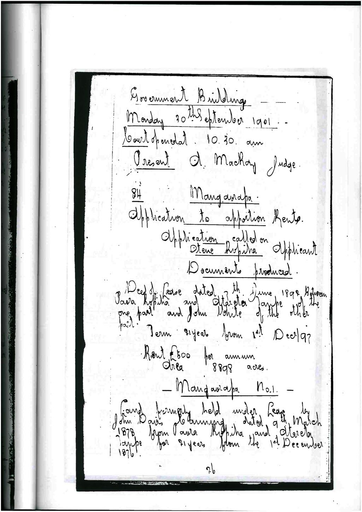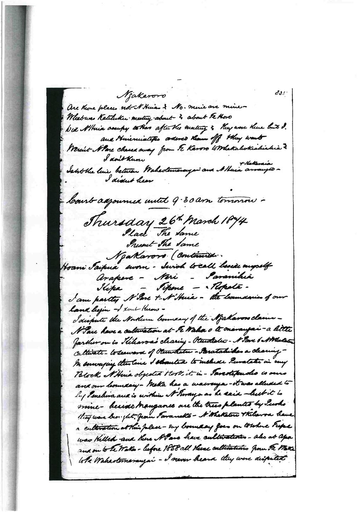2 April 1868
- Description
455-472 1868
Thursday April 2nd
Court sat at 10 am.
Present – same judges and assessors
Himatangi - continued
Paramena Te Naunau - sworn
Live at Patea up Rangitikei, Te Paneiri.
Remember Ngatiraukawa leaving Himatangi after battle of Motuatara.
We came away with them to Manawatu. We came here on account of the chiefs, Hirawanu.
Hinei Ipaia daughter of Te Ao Kautere was wife to Hori Te Kaharoa ‘teina’ of Te Wanikau chief of Ngati Upokoiri - came by way of Tamaki – the other side of Te Ahu o Turanga. Settled first at Tinitau.
Tiweta and Mahuri chiefs of Rangitane. They said to us “E noho i Manawatu. Ka hi atu ki a koutu Te Ahu o Turanga taenoa kit e puau of Manawatu. Ko nga waewae tera o Kapiti”. Teweta gave his daughter Pange to the son of Rauu Paturoa, Te Uruorangi. Himatangi was included in the gift of Manawatu from Tinitau.
We came to Puketotara where Mahui lived, and lived there with Rangitane and Mahui.
Mahui and Teweta said, “Te aruhe mau, kei Himatangi”. “If you go to get fern root don’t cook it there lest you go back and find none – fern root and eels and ‘koko’, and ‘kereru’ and ‘ngarara tuatara’”.
Ngati Upokoiri went and got fern root at Rangimai Tawhiti, close to Himatangi. Himatang is a sand hill. Matene Te Matuku of Ngatiapa had planted potatoes there first. Pakura of Ngatiapa and Tane cultivated. Te Upokoiri cultivated or Matene Te Matuku i Te Aputu was the name of the cultivation. They were large cultivations. There were 540 of Ngati Upokoiri.
There were no Ngatiraukawa living there then. They were at Otaki and a section of Ngati Upokoiri.
Remember Taraotea coming there. The place where he lived when he first went there was Opiki. Te Raotea’s party, 100 in number went up there after the fight of Haowhenua. He landed at Puketotara, the ‘pa’ of Ngati Te Upokoiri. They went to Himatangi and eat the food of Te Paeiri and hoke their ‘mahanga’ birds on Oroua.
Ihakara and Patu Kohuru were in that party and went and took the birds. They returned and fixed their residence at Opiki. The first residence of Taraotea was on the other side of Manawatu. We called the name of the place ‘Ahimate’. Not long there, when they crossed Manawatu to Opiki and lived permanently. His ‘pa whakairo’ was above Opiki. Te Paneiri lived. Te Rewarewa on this side of Manawatu remained permanently there.
Up the Manawatu there were other places. Himatangi was a ‘mahinga kaituna’ and ‘manu’ up to the ‘whakapono’ from time of Te Rotoatera to the ‘whakapono’. At that time crossed to Moutoa. Were always catching eels there and where the kai was. The potato cultivations were at Kurukautete and Motu and Rewarewa – were cultivating on both sides of the river.
Pakingahau is on the other side of the river. The ‘roto tuna’ where we got eels on the Himatangi side are ‘Oriko’ close to Manawatu, Ototara in Himatangi, Herangi near Whitirea, Te Rotoapa near to Whitirea also.
Wawa, on the south of Himatangi by the side of the road, Te Whangai o tai hauru, on the seaward side of Himatangi. Tiramoe at Himatangi. Te Awa o mahea also at Himatangi. Okemahu near the kahikatea near Omarupapako on the line spoken of by Parakaia – these are all.
The Rangitane and Ngati Upokoiri got eels from these places up to the time of going away of Ngati Upokoiri, at the time when Karaitiana came. Don’t know whether Ngatirakau had cultivated at Himatangi. Never saw any cultivation of theirs. Don’t know when Ngatirakau went to live at Papakiri. We had gone away. Don’t know if they were living there before we left. Opiki was the place where they lived up to the time of our leaving. The ‘pa’ whakairo’, Whakatere, was there.
In Mr. Hadfield’s time, Ngatirakau used to come to moutoa to service. Came on Saturday and returned on Monday. Used to come in obedience to notice from Archdeacon Hadfield. Whakatere, Rangitane, Ngati Upokoiri and other tribes used to come and on Monday they returned. A road from Moutoa to Puketotara and on to Te Ahu o Turanga was opened by the Ngati Upokoiri at that time. Did not hear Ngatiraukawa claimed there at that time. The ‘mana’ of Manawatu at that time was that of Ngati Te Upokoiri and Rangitane – two ‘hahi nui’ – one at Otaki, one at Moutoa.
Bishop of New Zealand came here with Renata ‘teina’ of Te Wanikau. When they saw the ‘nui o te whkapono’ Renata said “Your ‘whakapono’ is great ‘me hoki koe ki Heretaunga’, that you ‘whakapono’ may ‘tupu’ at your own ‘kainga’ “leave the land of Tiweta” Paneiri agreed.
Renata returned to Bay of Islands. Mr. Colenso was appointed Missionary for Heretaunga. When Renata got there, found Ngati Upokoiri had not arrived there, and he and Karaitiana came to fetch us. Ngati Upokoiri said, “Rangitane ‘to whenua’ Ngatiapa! to whenua! Te Hirawanui! to whenua!
Hirawanu and Ngatiapa assembled with Rangitane at Moutoa and the land was returned to Te Hirawanu and Tipae and a ‘pa’ was built at Marotiri, below Moutoa, by Te Hirawanu. Karaitiana and Renata came and Upokoiri left.
Heard of Mr. William’s boundary fixed in 1848, here in the court. I know that there was a dispute between section of Ngatiraukawa and the post was put in. Rangitane were for joining in the dispute. Te Whetu, chief of Ngatiraukawa said, “Don’t join in our dispute. It is not a dispute with you or about your land”. That is all I know about it.
When we were living and cultivating at Himatangi, I did not know of Parakaia. I know only Taraotea and his son Paratene who was a ‘kai karakia’. Remember when Colonel Wakefield came to buy land posts were put in, when Manawatu was sold to E. J. Wakefield.
Matiu Te Tohu, Chief of Te Upokoiri, was the ‘pou’ at Moutoa, the boundary was put at Marotiri. Matiu was at Manawatu, Hori Te Hanea of Ngatiapa was at Omarupapako and Hakeke at Kaiiwi – at the sale of Te Awahou heard that Matiu’s ‘pou’ was taken to Pakingahau. Heard that Nepia said “Ihakara you must not come beyond this”, he extended his arms. That was an illusion to that boundary of Matiu which was a boundary of land of Ngatiapa and Rangitane. I heard this.
Xed by Mr. Williams
Lived at Himatangi after the affair at Te Roto a tara. I was there at that ‘pa horo’.
My father was a chief. I am not. I was a ‘mokai’ of Waikato and Ngati Maniapoto, not of Ngatiraukawa. Wharekura was my ‘matua’. He is a Waikato and Ngati Maniapoto. Don’t know that Ngati Maniapoto is a name of a ‘hapu’ of Ngatiraukawa. I don’t know Wharekura to be a Ngatiraukawa. I was not a ‘mokai’ at Roto a tara. I had been returned and ‘whakarangatiratia’d by my chief.
I came here on account of the ‘pakeha’ and of Rauparaha and to seek arms and ammunition. We (Ngatiraukawa) were beaten by Ngati Kahungungu and came away from Heretaunga in consequence – Ngati Kahungungu were ‘patu’ by Ngatiraukawa at Te Roto a tara. When we came, the only people I know who were living at Oroua were Ngatiawa and Ngatitama and at the mouth of Manawatu were Ngatiwhakatere, Te Purangi, (chief is the kappa wha ka). These were the only tribes I heard of. Did not hear of Ngatikauhata living at Oroua or see them - was living at Puketotara. I did not go up Oroua.
I said that Te Wheta and Mahuri gave the land to Ngati Te Upokoiri to the mouth of Manawatu. Ngatiraukawa were then at Otaki. Both sides of Manawatu to the mouth was given. Mahuri and Ti Wheta were great chiefs of Rangitane. The land is Mahuri’s and Ti Wheta and Te Hirawanu.
Ihakara Tukumaru has no land there. Nepia Taraotea has no land on this side of Manawatu.
There were no boundaries named when the land was given to us - parts of Manawatu on both sides to the mouth. When we returned, we gave back these lands to Rangitane. In those days it belonged to Ngatiapa and Rangitane. Since the ‘whakapono’ the land, this side of Manawatu is Ngatiraukawa’s. It is yours and Muaupoko now. I won’t say whether it is not Ngatiapa and Rangitane. The other side belonged to Ngatiapa and Rangitane also Muaupoko – not Ngatiraukawa.
I have seen the map for the first time here standing in this place. I went to the public house but I did not see that sketch. I saw Mr. Fox and Buller but I did not have any talk with them and did not see the map. Did not talk about Himatangi. I did not talk with Mr. Buller. There were a great many people of Ngatiraukawa and Ngatiapa there. I know how to read. I see the map for the first time and understand it because I can see the names written.
Te Hirawanu and Karaitiana sold Te Ahu o Turanga to Government. Te Hirawanu received the money. Ngatiraukawa did not join in the patu because Hirawanu and Rangitane had the ‘mana’ over the land and they sold it. Hirawanu and Rangitane arranged the boundary. I was at Heretaunga, heard what took place. Did not hear that Ngatiraukawa gave back the land to Hirawanu. If it had been land which Ngatiraukawa had occupied, I should have known that they had arranged the boundaries but it was land which Ngati Te Upokoiri had occupied therefore I knew that it was Hirawanu who sold the land.
Know the nature of an oath and the law about a witness speaking falsely on oath.
John Tiffin Stewart – sworn
I am a civil engineer in the employ of the provincial government of Wellington. The tracing (produced) is mine. It was prepared by me on the 24th of March.
The river is copied from an actual survey made by me in 1859. I recently went over the ground shown in that sketch for the purpose of ---- at the cultivations. My sketch shows the river frontage of the Himatangi block as shown in the sketch before the court (shown to witness). I have been several times over the ground shown in the sketch before the court and the tracing shows all the cultivations recent and old that I know of. The cultivations, with the exception of some at Te Himatangi, are included between the dotted line in the tracing and the river. The land which appears to have been actually cultivated within this line, I estimate to be about 300 acres. The cultivations at Himatangi are small. I saw old and existing cultivations on this side of the river. The position where stood the ‘kahikatea’ tree near Whitirea has been approximately fixed as shown to us by natives and as shown on the tracing.
The existing cultivations are for the most part in the bends of the river. There is a village at Papakiri. Could not say from the appearance of Papakiri how long it has been occupied.
Xed by Mr. Williams
The ‘Kahikatea’ tree is about a mile from the river. There is a line cut for a cult. I do not know the boundary of the Himatangi block on the line. I know Whitirea. I have been surveying in the Manawatu in 1858, 1859 and 1865 in charge of surveys there. First time I was surveying under Mr. McLean, I believe the natives now living on the Himatangi block are Ngatirakau. Don’t know if they are the same natives as were living there in 1859.
I saw Paratene there in 1859 but did not see Parakaia at that time. Did not know the natives sufficiently to know what tribe. I have not seen the cultivation in the Himatangi bush.
By court
There are about 1000 acres between the dotted line and the river. Have not completed the area. I only know the boundaries of the Himatangi block. Know Omarupapako bush. Don’t know Paepae. I only examined the cultivations on the river bank. Was told that there were none beyond. Can’t state of my own knowledge that there are no cultivations inland of the dotted line.
I have been over the block. I had been over the country which is open and along the road which is about 3 miles from the river and never saw any cultivation. Keremeta accompanied me when I made this examination. It was he who gave me all the information (in red ink on the map) and who told me there were no cultivations inland of the dotted line. I believe Keremta belongs to Ngatiraukawa.
Ihakara and Hohepa and another Maori accompanied me there the week previous.
The sketch is a tracing from a plan drawn to scale.
Mr. Fox – stated that he considered it his duty to state that the witness Paramena Te Naunau had stated a falsehood in stating that he had not seen the map.
Paramena – admitted that he had told a lie and was reprimanded and cautioned.
Court adjourned at 1 pm for an hour.
Court resumed at 2 pm.
Matene Te Matuku – sworn
Rangitikei. Ngatiapa. I have lived at Himatangi. It is my land. It is from my ancestor occupied it before Haowhenua. I was at Haowhenua, after the fight was over I returned to Himatangi. Ngatiraukawa had not then crossed the river to Himatangi.
I cultivated at Papawharangi, Te Aputa, Te Ara ahiku – these are forest cultivations near Himatangi bush – planted potatoes, took birds and eels there – my ‘teina’ were my companions – Te Makomako Pirika Te Kakapa, Te Kuru and Nikaera.
Himatangi is a sand hill on the road to Puketotara. The ‘roto tuna’s were Te One tu rakau, Wawa, Te Whangai o tai, Te Wai a mahea, O te Kura, Paranui, Totara, Okunehe (kei te taha o te uri o te kuini) te wai o hau, Pokuru, this is close to Manawatu. These places are all at Himatangi.
After Haowhenua, Taraotea lived at Opiki - ‘kainga tuturu’, Ngati Te Upokoiri were at Te Rewarewa. They cultivated on the north side of the river.
Remember ‘Te Kuititanga’ – was at Himatangi. Did not know that Ngatiraukawa had then claimed Himatangi.
Remember the coming of Mr. Williams and the blankets and treaty. He came to Tawhirihoe. I was at Himatangi. I was fetched and went. I did not sign it, Ngatiapa had signed and the blankets had been given.
I know the Ngatiapa chiefs who signed treaty – Te Hanea Te Hakeke, Mohi Mahi, Hamurera Taumaru signed at Tawhirihoe. That was a great ‘pa’ of mine. The ‘pa’s occupied by Ngatiapa at the time of treaty were Tawhirihoe, Te Awahou, Poutu, the ‘pa’ on the other side, Parewahine. One at Kaikokopu lake – Ohairu. There was a ‘pa’ at Oroua but my friends will tell about that. I can only speak of Himatangi. There were cultivations of Ngatiapa there, between Oroua and Manawatu. My friends will tell their names. Don’t know of any other tribe but Ngatiapa cultivating at Himatangi at time of treaty. Rangitane were cultivating. I had a cultivation at Oroua, Mangawhata between Rangitikei and Oroua at Te Rotonui a hau – eels and potatoes – between Rangitikei and Oroua, Te Putaangi eels and potatoes between Rangitikei and Oroua – Ngawhakaatu potatoes and eels between Rangitikei and Oroua – Te Awahuri potatoes between Rangitikei and Oroua in the Rangitikei Manawatu block these are all the ‘moana tuna’ birds were taken in other places. My friends will give names of other places.
When the other side of Rangitikei was sold, I gave up catching eels. After ceasing to cultivate at Himatangi went to Koputaara. I took the money for Himatangi. I ceased to cultivate potatoes but took eels and birds – cultivations were large.
Ngatiraukawa stole my land and worked in my cultivation. Continued to catch eels to the time of sale of land. I did not know Parakaia. All I know of him is that, I burnt his house and his ‘pou’ at the ‘roto tuna’. I was at Kaputara but I went to Himatangi to catch eels. Burnt Parakaia’s ‘pou’ because the land was mine.
Xed by Mr. Williams
I have houses at Koputaara. I have no houses at Himatangi but I take produce from Himatangi and let it there, at Koputaara. I have no crops at Himatangi. Get eels only from there. I ceased to plant potatoes at Himatangi the year of the sale of Rangitikei.
When the first money was paid for Rangitikei block, I ceased to plant potatoes. I cultivated there the year Rangitikei block was sold. I ceased to cultivate at Himatangi – took eels and planted potatoes at Koputaara. Don’t know the time of Ngatiraukawa coming. I was at Whanganui. I don’t know of my friends being ‘patu’d or ‘hopukia’ by Ngatiraukawa at Himatangi. Ngatiapa were ‘patu’ by Ngatiraukawa – ‘he pohata’.
Hamuera’s mother was taken but she is not a chief perhaps she was ‘hei aha maku’. Te Whareki was killed. He was a chief but ‘hei aha maku’. The chiefs ran away but they ran away on their own ground. Himatangi was not left. My people were at Himatangi. They were not killed there. They remained at Himatangi. Before Ngatiraukawa came, my people were beaten by Ngatitoa. Ngatiapa were not the ‘hoia’s of Ngatiraukawa at Haowhenua. What do I care about the people of Ngatiapa who were living as places of Ngatiraukawa? The chiefs were not ‘mate i a Ngatiraukawa’. Ngatiraukawa did not take possession of Himatangi for themselves after Haowhenua. They did not live at Puketotara. Rangitane and Ngatiapa lived there.
I don’t know Te Kirikiri, Te Whata was the only one I know of who lived at Oroua. Of Ngatikauhata, Tapa’s and his ‘matua’ were all who lived at Oroua. I knew Te Whata, Hemo Kanga, Pukerimu, Te Ruirahi and ‘nga tamariki’ are all I know of. I know of Haerewharara and Nepia and Aperahama living at Rangitikei. They were great chiefs of Ngatiraukawa.
I am a chief. Ngatiraukawa went to catch birds for me – Horomona and Haerewharara, Ihakara also, as you have named.
I had no boundaries when I went to Himatangi. All the land is mine. This side of Manawatu as well, up to Waiwiri.
Ngatitoa are living on the lands between Manawatu and Rangitikei. They are the only persons I recognize.
Ngatiraukawa sold Awahou to government.
I sold the other side of Rangitikei to government to Mr. McLean. Don’t know what Mr. McLean said when the land was offered. Mr. McLean did not say that Ngatiraukawa had land there. I did not hear that McLean said that he must first obtain assent of Ngatiraukawa.
Ngatiraukawa did go to McLean to talk about sale of Rangitikei block. They went there to withhold my land on this side of Rangitikei.
I was my ‘kaha’ and ‘mana’, i mau ai tenei taha’. Don’t know, and did not hear that Ngatiapa proposed to sell all the land up to Manawatu. Ngatiraukawa ‘pupuri i tenei taha, hei whenua tuku mana’. They held it till they could obtain my consent for them to sell it. I believe that was their object.
I sold the other side in virtue of my own ‘kaha’. Don’t know if Ngatiraukawa assented. I was present at the Awahou meeting. At the sale of Rangitikei – I can’t say whether Ngatiraukawa assented. I do not know thatNgatiraukawa are occupying the banks of the river on the Himatangi block but not at Himatangi.
I don’t know about my cultivation being taken by Ngatiraukawa. I was not ‘paua’ by Ngatiraukawa. I don’t know that Ngatiraukawa had any cultivation at Himatangi. Ngatiraukawa took the cultivations on the bank of the Manawatu. It is only lately that they have occupied. I don’t know the year they began to occupy.
My ‘pana’ was the ‘pou’s and the houses I burnt. I burnt two houses at Himatangi. They have not been rebuilt. This was when they came across to Papakiri. Don’t know the year. It was the year they crossed from Opiki. Long before the sale of Rangitikei Manawatu block. They were ugly. The houses on the river were not burnt. They are standing now.
It was my ‘whkaaro’, that lease to Mr. Robinson. I leased that land ‘naku te whkaaro ki a Nepia’ thos e I knew as parties were Nepia only. Did not know of Te Paratene or Parakaia. I received the rent. The first lease was Ihakara’s, Nepia’s and Te Ahu Karamu. I was not a party but went to Nepia to get some of the money. The last year I got money, £5, from Nepia. I looked on Nepia and Ahu Karamu as the chiefs. I did not know of Parakaia and Paratene being parties to the second lease.
All I know was about the stockyard, put up to impound Mr Robinson’s cattle. I and Nepia received the rent. The money he got was given to him by Nepia and myself. Parakaia had £5. Nepia and I had £30 the first time. £15 was given to Ngatirakau and Parakaia, £20, Nepia and I had. Nepia and I gave the money. In one year £50 was received ‘ he oi ano, kua whawhai!’ I did not know that Parakaia and Paratene were leasing. The £15 was given on account of the stockyard put up by Parakaia. Nepia assented.
By court
Nepia had only the ----. Nepia was admitted by me. Ngatiraukawa had a claim and that claim was determined by the boundary of the Awahou block which was fixed by Hakeke, Hanea and Matiu. Nepia stood at Omarupapako and extending his arms said “Ngatiraukawa kua mutu ki a koe kua huri taku tuara ki a Ngatiraukawa taku aro aro ki a Ngatiapa”.
Further hearing adjourned till tomorrow.
Court adjourned at 4.30 pm to 8 p.m.
Court sat at 8 pm.
Present – Thos Hy Smith – J Rogan – Judges same assessors
Allots Nos. 116, 117, 118, 119, 90 and 92 Otaki – Tamihana Te Rauparaha
Continued from pp 191 (from pp 454, this book)
The court gave decision against counter claimant Riria Te Akau for No. 90.
It was ordered that a certificate of the title of Tamihana Te Rauparaha to two parcels of land at Otaki containing respectively a1 – r0 – p11 and a0 – r1 – p29 and known by the name of Allots Nos. 116, 117, 118 and 119 and allots Nos. 90 and 92 in the village of Hadfield Otaki be made and issued to the governor.
The court to recommend no restriction on alienability
Fees demanded to be paid by claimant
Invest £1 Cert £1 C Gt £1 Total £3.0.0
Court adjourned at 9 pm till tomorrow.
Identification
Taxonomy
- Community Tags

